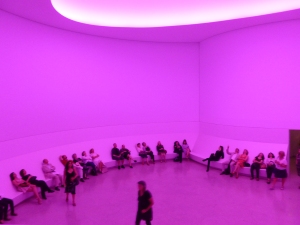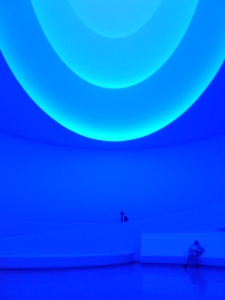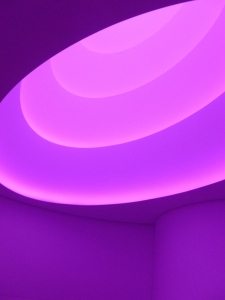This title is a quote by James Turrell from the speech he gave at the Guggenheim, New York, on Thursday at the opening of its latest exhibition, James Turrell. One of three major shows of his work being held across the US this summer (Los Angeles County Museum of Art and the Museum of Fine Arts, Houston) it also marks the first solo show he’s had in a New York museum since 1980. And it is no quiet come back. The main installation, Aten Reign, stands in the centre of Frank Lloyd Wright’s iconic atrium, a tower ascending in concentric ovoid rings of light that echo the Guggenheim’s own spiral rotunda. It is also the Guggenheim’s most ambitious installation to date, according to associate curator Nat Trotman.
Aten Reign itself is a hybrid: both part of the Skyspace family – a series of openings in the ceiling or top of an installation that are subtly affected by the shifting sky – it is also Ganzfeld (German for ‘complete field’), his immersive, tone-shifting works that feel like you’re walking into a luminous substance. It is particularly striking because of its relationship with the museum. There is no doubt that the Guggenheim is tough for any artist (indeed, Turrell’s title quote is a responsive to this). Unlike the white cube, which can purposefully pull away to let a work sit in it, the Guggenheim’s overwhelming grandeur and peculiarity contends with the work, sometimes compliments it, but never truly allows it to breathe. This wasn’t a problem for Turrell, it seems. He covered it. In some instances artists’ creations can’t compete, however.
Turrell’s pieces tend to involve a lot of construction to build the frame or manipulate the space to successfully generate the sensations of floating, intensity, reflected light and changing colours, characteristic of his work. The rotunda space that is expressed from the outside in Wright’s Museum has been replaced with a wash of hues that glow and drench the people beneath it, standing dead centre, lying underneath and reclining around the floor’s edge. Around the edge of the balcony, Turrell’s team has stretched a white fabric so that it is an enclosure – a matryoshka doll. By building within it, Turrell has reclaimed the space for the light. At the same time, the space and installation are well matched: craning your neck to take in the full winding lines of Wright’s elegant interior, one’s eye follows the spiral to the top, the glazed roof, while Turrell’s Skyspaces draw your face towards an impossible flattened sun, in both the viewer bathes in a gently pulsing light, artificial or real. “Frank might even like it.. so it’s ok,” he said of the famously fussy architect.
It’s a struggle to describe Turrell’s work. Sensual comes to mind most often, but so does consuming and calm, as in Olafur Eliasson’s The Weather Project. Perhaps the sensation that you are being enveloped in anything not tangible evokes these words, though, and for each of the piece’s continually shifting hues, there is a slightly different set of imagery, all tunnel-like: blue is futuristic chamber, peach and pink womb-like, while the white speaks to religious ascension. As Wil Hylton writes in The New York Times Magazine, it is difficult to describe Turrell’s work successfully without sounding cliched or eagerly jargonistic, echoing the sometimes impenetrable language for which Turrell himself is known. The “thingness of light” and the “alpha state” are examples Hylton gives, but observes as well that “without these terms, it would be nearly impossible to discuss his work. It is simply too far removed form the language of reality.”
Light is difficult to describe. Turrell makes it sound easy. In his speech to a flock of keenly captivated press in the bowl-shaped basement auditorium, Turrell talked about the eye, the pupil’s mechanism and how people are not made for the light, instead we are accustomed to the dimly-lit caves from which we crawled. His mediation of light and creativity to make voids, solids, spaces that don’t exist as well as illuminating those that do is incisive, specific, and humorous.
But Turrell has done something more powerful than just place his work around the landing-like gallery spaces and overwhelming balcony interior – he has filled the space. The Guggenheim is a notoriously difficult space to work with, it prompts noxious attitudes towards the ego of the architect as much as eliciting a degree of reverence for such a singularly stylised museum. It seems that with a lot of installation work, there is an effort to respond to this overwhelming shape and structure. It is inspirational but also obstructive – it is hard to see the art for the building. In the past, artists have employed ambitious devices – Cai Guo-Qiang‘s I Want to Believe, 2008, installed a pack of wolves winding their way around the balcony rotunda used the inherent movement in the space; more recently, Maurizio Cattelan: All, 2011, filled the atrium with a cacophony of suspended objects, paraphernalia (and a horse). Still, the museum was at the centre.
The show is also, like many atmospheric, time-based media and public installations that seek to evoke a feeling, accessible, completely enveloping and all consuming. People are bathing in the conical atrium under an ever-changing glow. An assistant at the museum is talking to the security guard about how it feels like you can almost touch the space. This kind of art is truly public. It is intimate and open. Although the periphery spaces along the museum ramp hold some of Turrell’s oldest and most profound work, such as the illusionary Afrum I (White), 1967, a bright light projected into a corner that seems to form a solid cube, serve as a certain context, they are somehow weak – perhaps it is the burden of the Guggenheim itself again, or that in the day the rooms are not dark enough to do justice to the impact, but they don’t sing like the main piece. Perhaps they aren’t meant to. It is a great shame, though, because these are in essence the stuff that Turrell is made of – the roots and the genius loci for his obsessive creativity. Indeed, for this author their lo-fi, home-grown origins (Turrell played around with pointing projectors and making holes in painted windows in the Sixties) speak to his ongoing land art project, Roden Crater, where Turrell is scratching at a surface trying to invite light and bring the sky in.


